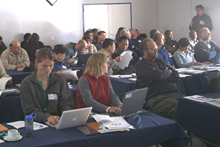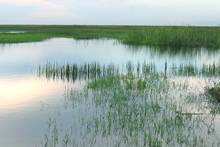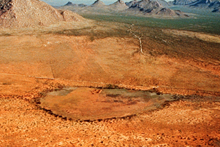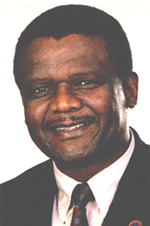Engagements of international context
Editorial by Johan Pauw
|
One of the highlights on this year's international relations calendar was the meetings of the Environmental Long-Term Observatories of Southern Africa (ELTOSA) and International Long-Term Ecological Research (ILTER) held at the Gobabeb Research and Training Centre in Namibia in August.
SAEON delegates played a prominent role in the meetings. SAEON's recently appointed Observation Science Specialist, Tim O'Connor, Information Management Coordinator Avinash Chuntharpursat, and Bob Scholes all presented papers of a high standard. Tim O'Connor, Wandile Nomquphu and I chaired various sessions, including the ELTOSA Annual General Meeting. Bob is the CSIR member and Wandile is the Department of Water Affairs and Forestry member on the SAEON Technical Steering Committee.
Avinash was elected vice-chair of the ILTER information management committee, and I participated in several after-hours ILTER Executive Committee meetings during the course of the week.
|
The meetings presented unique networking opportunities for SAEON. Due partly to the unique desert setting, the sixty delegates, who hailed from all over the world, interacted very well and spent long fruitful hours working towards the improvement of the organisation of ELTOSA and ILTER.
As a measure of how well the delegates interacted, it was quite remarkable that no permanent small groups were formed during mealtimes, as is often the case when people from different parts of the world and different cultures meet.
All Scientists Meeting
September brought another international relations highlight for the year when Tim O'Connor, Avinash Chuntharpursat, SAEON Elwandle Node Manager Angus Paterson and I attended the tri-annual All Scientists Meeting of the United States Long-Term Ecological Research (USLTER).
As vice-chair of the ILTER information management committee, Avinash participated in the USLTER's Information Managers' Meeting, which was also attended by a long-standing SAEON partner, Judith Kruger of the Kruger National Park.
The All Scientists Meeting gave SAEON delegates the opportunity to attend a selection of its 50 workshops focused on the broad spectrum of LTER topics, including Information Management and Education. As one can imagine, a tri-annual meeting of a network of 1 800 scientists backed by millions of US Dollars presented an excellent networking and relationship-building opportunity for SAEON. The SAEON delegation was partly sponsored by the USLTER, with funding from the National Science Foundation.
The SAEON delegation also undertook an intensive two-week study tour of several USLTER sites. Sites on the intinerary were the Jornada Basin, Sevilleta Wildlife Refuge, Florida Everglades and Central Arizona-Phoenix. The sites were selected for their relevance to South African environments.
|
Both Jornada and Sevilleta are located in arid areas. The overall goal of the Jornada Basin LTER programme is to quantify the key factors and processes that control ecosystem dynamics and biotic patterns in Chihuahuan Desert landscapes. These landscapes are representative of many arid and semi-arid ecosystems of the world where dramatic changes in vegetation structure and ecosystem processes have occurred over the past several centuries. The changes are often interpreted as "desertification", the broad-scale conversion of perennial grasslands to dominance by xerophytic woody plants and the associated loss of soils and biological resources, including biodiversity.
Sevilleta National Wildlife Refuge is near Albuquerque, New Mexico. It is managed primarily as a LTER research area. The Refuge, which is managed by the US Department of the Interior, Fish and Wildlife Service, and its surroundings, are positioned at the intersection of several major biotic zones: Chihuahuan Desert grassland and shrubland to the south, Great Plains grassland to the north, Piñon-Juniper woodland in the upper elevations of the neighboring mountains, Colorado Plateau shrub-steppe to the west, and riparian vegetation along the middle Rio Grande Valley. Because of the confluence of these major biotic zones, Sevilleta presents an ideal setting to investigate how climate variability and climate change act together to affect ecosystem dynamics at biotic transition zones.
Everglades National Park is the largest subtropical wilderness in the United States. The area boasts rare and endangered species, such as the American crocodile, Florida panther, and West Indian manatee. It has been designated an International Biosphere Reserve, a World Heritage Site, and a Wetland of International Importance.
|
Central Arizona-Phoenix is a site for urban ecology. The Central Arizona–Phoenix Long-Term Ecological Research (CAP LTER) site provides a unique addition to the LTER research by focusing on an arid-land ecosystem profoundly influenced by the presence and activities of humans, and is one of only two sites that specifically study the ecology of urban systems. Biological, physical, and social scientists from Arizona State University and a wide range of local partners are working together to study the structure and function of the urban ecosystem, assess the effects of urban development on the Sonoran Desert, and define the impact of ecological conditions on urban development.
Meanwhile, back at the ranch …
The recruitment process for managers for two SAEON nodes shows good progress. Interviews were held for the node manager position at the SAEON Ndlovu Node, and a short-list of candidates was drawn up for the SAEON node for marine-offshore ecosystems. We look forward to filling those vacancies in the near future.
Mintek agreement
|
Undoubtedly another of this year's highlights has been the accession agreement signed on September 1 between SAEON and mining researcher Mintek. The agreement allows for the exchange of research data between the two organisations. The data will be made available to all Mintek and SAEON's partners, as well as to the public.
The partnership is extremely significant, not only for SAEON, but for sustainable development in general. Both SAEON and Mintek are in the "science" business. SAEON's currency is reliable data, data that will enable us to make objective assessments about the current state of our environment, and projections about possible future impacts to provide strategic input to policy-makers. One of Mintek's strengths is to develop technology and mitigating solutions for the mining industry in order to reduce the environmental impact.
SAEON's partnering with leading South African institutions facilitates cross-pollination between nodes, universities, science and technology institutions, conservation agencies, government departments and non-governmental institutions.
|
Welcome to new NRF President
In conclusion, SAEON would like to welcome the new President and CEO of the National Research Foundation, Prof Mzamo Mangaliso back to South African shores. Fresh from his position as Professor of Management at the Isenberg School of Management at the University of Massachusetts in the US, Prof Mangaliso brings a vast array of skills and expertise, particularly in strategic management, to his new position.
















